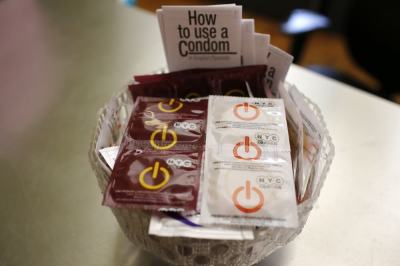Do we think condoms are good for kids?

The Associated Press ran an article last week on declining condom use in young people. “Condoms aren’t a fact of life for young Americans. They’re an afterthought.”
I am featured in the article addressing the reasons we are seeing this decline here in the United States and around the world. As is often the case, the author, who clearly had a different perspective than mine, included just two sentences from our 30-minute interview. Like Paul Harvey used to do, I’d like to share “the rest of the story” on condoms and kids.
The AP reporter stated early as one of the reasons for the decline: “So far, experts have told me that the patchwork of sex education across the country is a contributing factor. In states where abstinence-only education is prioritized, advocates I spoke to said people may not be getting the education they need to have safe sex, therefore contributing to a decline in condom use.” Her first supposition was that programs teaching abstinence (and not pushing condoms) were to blame for kids not using condoms.
I first corrected her use of the limiting term “abstinence-only” with the professional term of sexual risk avoidance (SRA) or optimal sexual health education and shared with her key published research demonstrating these programs don’t produce a lowered condom use rate among sexually active teens. They do produce lower rates of sexually active teens overall (and shouldn’t that be commended?). In the piece she did use “abstinence-focused” instead of “abstinence-only,” but opponents still avoid validating the sexual risk avoidance (SRA) approach.
I also corrected her use of the inaccurate term “safe sex” as most professionals agree there is no safe sex for teens. (The correct term is “safer sex” when risk reduction methods are used).
What she was grossly uninformed about are the physical risks of adolescent sexual activity and the limitations of condoms to protect kids from them. Here are a few facts from the Centers for Disease Control website on condom use:
- Condoms will provide protection against STDs spread by genital fluids (such as gonorrhea or chlamydia).
- Condoms will not provide protection against STDs spread by skin-to-skin contact (genital herpes or syphilis)
A few missing facts here (found elsewhere on the CDC site):
- Herpes is a virus that can cause life-long recurrence of painful blisters.
- Syphilis is a great risk to babies of infected mothers. Congenital syphilis is the fastest growing STD, with 3,700+ babies infected nationally in 2022.
- Tragically, not mentioned in the list of skin-based STDs and NOT protected against by condoms is Human Papilloma Virus (HPV) the “most common STI” that can cause genital warts and cancers.
The AP reporter asked me if I thought telling kids this information would discourage them from using condoms. Have we set aside “informed consent” as a key responsibility of healthcare? Tragically, “comprehensive sex education” advocates often accuse SRA programs of withholding medically accurate information from young people. The exact reverse is true, and most teens do not have this critically important understanding of their risks. We do them a disservice by overstating the effectiveness of condoms.
Another key fact I shared with the AP reporter (that wasn’t included) is that most young people are not having sex. In the United States, according to the most recent CDC Youth Risk Behavior Survey, 70% of all high school students have not had sex (a number that has declined steadily and significantly over the past 20 years).
The decline in condom use has also been observed internationally. A recent World Health Organization report announced an “alarming decline in adolescent condom use” with the results of a study from 42 countries. The key finding of the WHO report is that “among adolescents who reported having sexual intercourse (who by the way were only 11, 13, and 15 years old), 61% of the boys and 57% of girls reported using a condom at last sexual intercourse.” Since 2014, those numbers have declined 9% among boys and 6% among girls. What wasn’t highlighted was that 80% of the boys and 85% of the girls had not had sexual intercourse.
The report calls for expanded funding and policy support to further advance “comprehensive sexuality education (CSE).” However, the countries included in this report, particularly Europe and Canada, are the countries known for advancing the most progressive CSE programs in the world. Advocates for CSE have been at this a long time across the U.S. and abroad, promoting “condoms and consent” for youth, and as broadly confirmed in this report, their efforts aren’t producing the evidence they assure the world they can.
The CDC instructs on the need for “consistent and correct” condom use. As shown in the WHO study, and also in the YRBS trends, teens aren’t able to achieve consistent use, and their use rates are declining. As I explained to the AP reporter, a key factor to this decline is pornography. Now called “the new sex education,” pornography is normalizing unprotected sex (and tragically also sexual violence). Social media certainly doesn’t promote condoms and accurate information about their effectiveness and ineffectiveness.
“Correct” use of condoms is described in a sequence of detailed steps including correctly purchasing, storing, opening, lubricating, applying, removing and disposing the condom. These are advanced skills that research has shown even adults have trouble achieving consistently. Young people are often under the influence of alcohol or drugs, as well as hormones and sexual desires, and their prefrontal cortex where executive brain function happens is still developing. These factors together help us know that “consistent and correct use” of condoms is an unrealistic solution to protect the health of kids. (And they certainly don’t offer any protection against the documented emotional and mental risks of adolescent sexual activity).
The WHO researchers show their bias in this concerning statement: “Sexual initiation is an integral part of adolescents’ transition to adulthood.” Unfortunately, key policy leaders and educators deny that they encourage youth sexual activity. We often hear as a justification for pushing contraception that “kids are going to do it any way.” (Though, as referenced above, a FAR majority of them aren’t). This telling statement normalizing sexual initiation as a rite of passage to adulthood shows CSE’s motivation goes beyond “they’re going to do it” to “they should do it.”
So maybe condoms shouldn’t be encouraged. Maybe clear direction and compassionate support for avoiding sexual risks and saving sexual involvement for, as the CDC says, “a mutually monogamous relationship with an uninfected partner” (which most of us think of as marriage). SRA and optimal sexual health education programs provide this and much more, including positive character and healthy relationships, communicating and maintaining boundaries, and accurate, complete information on pregnancy, STDs, and contraception.
Former President George W. Bush is credited for the phrase “the soft bigotry of low expectations.” If we expect kids to fail, they probably will. If we instead work together toward a vision of health and hope, with what’s truly best for them now and in the coming years, they will be best set up for success. And when kids grow up to be successful adults, their families, our communities, and our nations are all best set up for success.
Lori Kuykendall is President of Beacon Health Education Resources. She has worked in health and sex education for schools and churches, and with parents and policymakers since 1995. She led the national team that wrote the Universal Standards for Optimal Sexual Development. Lori earned a Master’s Degree in Public Health (MPH) from Liberty University. She has been published in The Washington Times, The Washington Stand, Live Action News, and The Dallas Morning News.




























